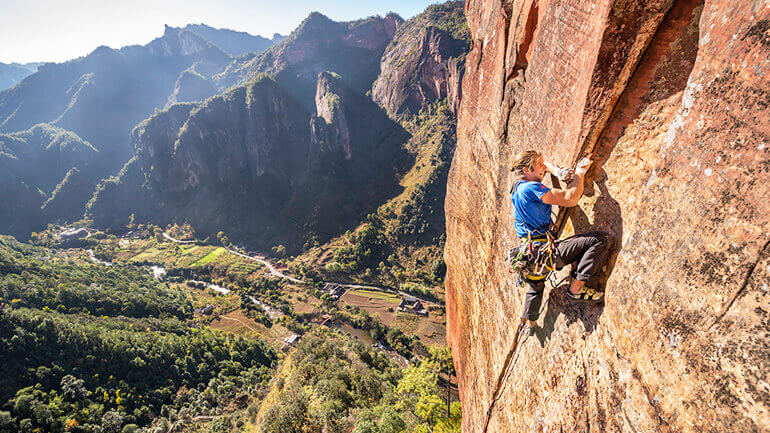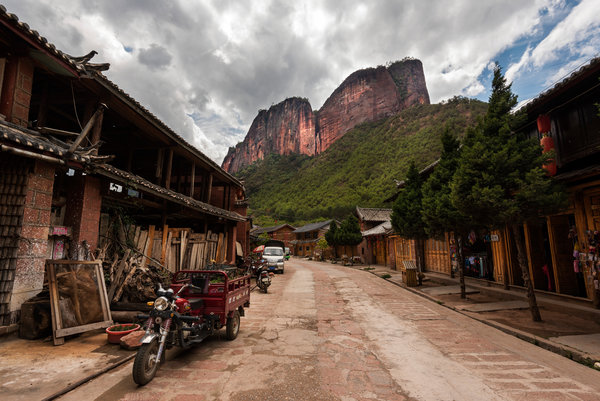Michael Dobie moved to Liming in September 2010 with two friends who discovered the Chinese village in a travel brochure. Crisscrossed by dirt roads, the rustic setting in the mountains of Yunnan province offered few amenities.
2010年9月,迈克尔·多比和两个朋友搬去了黎明村。正是这两个朋友在一本旅游指南中发现了这个中国村庄。这里位于云南省的山区,泥土路纵横交错,几乎没什么便利设施。
"It was pretty wild," Dobie said. "People were walking miles into town for supplies. It was kind of just one street, that type of traditional village."
"非常偏远,"多比说。"进城买东西要走很远的路。差不多只有一条街道,就是那种传统的村庄。"
But the group came with a purpose – to establish traditional, or "trad," climbing in China – and for this, Liming offered two advantages. First, its endowment of soaring sandstone cliffs was rich with cracks and crevices ideal for the sport. Second, the local government embraced their vision and granted permits to explore the surrounding crags. In the early months of 2011, Dobie set out cleaning routes, removing undergrowth and knocking away loose rock. By the summer, he'd finished more than 40.
但他们来这里是有目的的,在中国推广传统攀岩,而在这一点上,黎明村有两个优势。首先,这里高耸入云的砂岩悬崖上布满了裂口和缝隙,非常适合进行传统攀岩。其次,当地政府支持他们的设想,准许他们探索四周的悬崖。2011年初,多比开始清理路线,清除矮树丛,敲掉松动的岩石。到夏天的时候,他已经清理完了40多条路线。

Traditional climbing differs from other varieties like sport climbing in the method climbers use to protect themselves against falls. While sport climbers tie into a line of permanently fixed bolts, traditional climbers carry along a set of removable anchoring devices that they jam into cracks in the rock face. The skill involved in making placements that will hold a person's weight and break a big fall adds difficulty, and the extra equipment costs are significant.
传统攀岩不同于运动攀岩等其他攀岩的地方,在于攀岩者用来防止自己跌落的方式。进行运动攀岩的人会把自己固定在一排永久固定的螺栓附近,而传统攀岩者会随身携带一套可拆卸的锚固装置,并把它们卡在岩面的裂缝里。攀岩者安放的装置要能承载自身的重量,在坠落时也能撑住。这其中涉及的技巧增加了这项运动的难度,额外的设备成本也很高。
In part because of these differences, sport climbing became popular in China as early as the 1980s while traditional remained all but unknown. By 2010, other southern cities like Yangshuo and Kunming had cultivated homegrown sport climbing communities, with hundreds of routes developed by multiple generations of enthusiasts.
在一定程度上正是因为这些区别,运动攀岩早在80年代就在中国流行起来了,而传统攀岩依然几乎不为人知。到2010年,中国南方的阳朔和昆明等城市都培养出了本土的运动攀岩群体,几代爱好者开辟出了成百上千条路线。

"I consider Yangshuo the Yosemite of China because it's where rock climbing started here, and it's the largest place in China," said Andrew Hedesh, a Yangshuo-based climber and author of a forthcoming guidebook on the area. But the dearth of traditional climbing frustrated Dobie.
"我觉得阳朔就是中国的优胜美地,因为攀岩就是从那里开始发展起来的,那里是中国最大的攀岩圣地,"身在阳朔的攀岩爱好者安德鲁·赫德什说。他写的一本介绍该地区的指南即将出版。但传统攀岩的稀少令多比感到失望。
"At the beginning I saw it as a service project," he said. "All the people developing over the last 20 years in China have all been foreigners doing sport climbing. So the Chinese, that was all they knew."
"刚开始我把它当做是一个服务项目,"他说。"过去20年里,在中国推广攀岩的人,都是进行运动攀岩的外国人。中国人也一样,他们只知道运动攀岩。"
Less than a year after its inception, however, Dobie's project took on an unlikely life of its own. Word of his efforts in Liming spread abroad, and professional climbers, including Matt Segal, began to notice. Segal visited Liming in 2011 to explore and develop new, more challenging routes, documenting his trip for a wider, international network of climbers with sleek videos and colorful articles.
然而,开始不到一年后,多比这个项目的命运出现了意想不到的变化。有关他在黎明进行的多项活动的消息传到了国外,包括马特·塞加尔在内的一些职业攀岩者开始关注。2011年,塞加尔前往黎明村探索和开发更具挑战性的新路线,并用优美的视频和引人入胜的文章记录下了自己一路的见闻,向更广大的国际攀岩社区介绍了这里。
The next year, Liming held its first trad festival, backed by major sponsors. Segal returned to participate.
第二年,黎明举办首届传统攀岩交流大会,得到了大型赞助商的支持。塞加尔重回故地,参加交流大会。
"It was crazy to go back to this area where I felt like I was developing routes for myself, to see dozens and dozens of Chinese climbing these 5.9s that I was like, 'Nobody's ever going to be climbing these,'" said Segal, referring to the Yosemite Decimal System which ranks climbs on a scale from 5.0 to 5.15.
"我曾在这个地区开发路线,当时感觉是在给自己开发,觉得'没人会来这儿攀岩',而今我回到这里,看到很多中国人在攀登这些难度系数为5.9s的峭壁,我觉得很兴奋,"塞加尔说。他指的是优胜美地登山难度系数,范围是5.0至5.15。
"Liming is turning into a world-class climbing destination."
"黎明正变成世界级的攀岩目的地。"
For most of China's modern history, a tumultuous political climate and strict regulations left the country closed off to any would-be foreign explorers. But as restrictions were eased in the late 20th century, its vast interior and potentially exceptional terrain have captivated the interest of climbers and outdoor enthusiasts worldwide. Mark Synnott, a professional mountaineer who was one of the first foreigners to climb in a newly opened Tibet in 2002, is among them.
在中国现代历史的大部分时间里,政治环境动荡,政府管制严格,任何外国探索者都无法进入这个国家。但是20世纪末限制放松后,中国广袤的内陆和潜在的独特地形引起了世界各地登山者和户外运动爱好者的兴趣。职业登山运动员马克·辛诺特是其中之一。他是2002年西藏开放不久时第一批去那里登山的外国人之一。
"One thing that stuck with me since that trip is how much of China, back then and still today, is unexplored," he said. "China may be the place that holds the biggest treasure trove of unexplored mountain territory in the world."
"那次旅行之后,我一直在想,中国还有多少地方无人涉足——不管是那时还是现在,"他说,"中国未开发山峰的宝库也许是世界上最大的。"



 闽公网安备 35020302035673号
闽公网安备 35020302035673号
0 responses on "Explore climbing spots in China (1)"